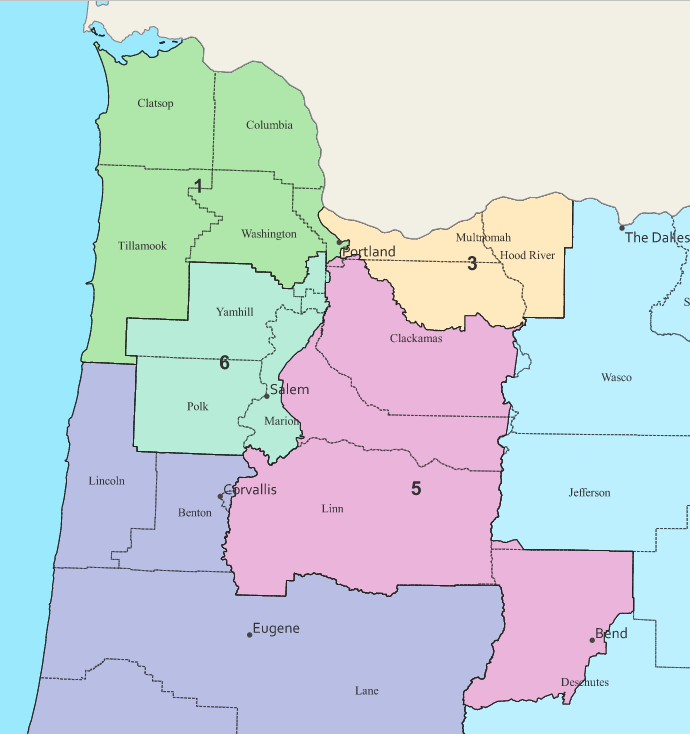U.S. House Elections Part 1: A New Congressional Map
October 19, 2022
District 5 Race
Oregon is experiencing a high-stakes and competitive election this year, facing a multitude of candidates for high offices in Washington D.C. and Salem. As Oregonians face inflation, crime, homelessness, housing affordability, and the resulting political strife, one question is who will represent the state as a whole and bring solutions.
After years of having one of the fastest growing populations in the country, Oregon has grown enough to include an additional congressional district. Added late last year, Democrat and Republican state legislators long conflicted over how to redraw and enlarge the House district map.
In a state house dominated by Democrats, leaders established a legislative redistricting committee and initially gave the Republicans equal seats in the group; allowing them power to veto unfavorable proposals. Under state law district map designs cannot explicitly benefit one political party or politician, yet who determines what is gerrymandered was a source of contention.
Democrat legislators initially released maps that were projected to favor their party 5-1 out of the 6 districts, which Republican legislators quickly vowed to block. The shared voting power on the redistricting committee was eventually reversed by then-House Speaker and Majority Leader Tina Kotek, who alleged Republicans had broken their agreement to stop blocking and walking out on bills in order to sit on the redistricting committee. By contrast, Republican legislators described the reversal as unfair, and criticized Kotek for ‘breaking her word’.
Ultimately enough Republicans were present to have two-thirds of the state house vote and pass the new congressional district map, which were signed into effect by Governor Kate Brown.
The new U.S. house district layout will include drastic changes to the areas south of the Portland Metro Area. Previously residents of Salem, Oregon City, west to Lincoln City and Tillamook were represented under Kurt Shrader of congressional district 5. Yamhill county was included with northwest Oregon under Suzanne Bonamici of congressional district 1.
District 1 encompasses most of the residencies of people in the Ida B. Wells High School community. With redistricting, it will now span farther east across Portland, as well as include Tillamook County. Including the new congressional district 6, residents of western Clackamas County, south of Beaverton, and of the Yamhill area will receive new representation. The 5th congressional district will experience a large realignment, severing its attachment to the coast and reaching farther east to the Bend area. Southeast Portland and Milwaukee, along with Canby, Lebanon, and Redmond will also be cities represented by the new district 5. Congressional district 3 represented by Earl Blumenauer, was previously isolated to the East Portland and Gresham area, and will now expand to Hood River county.
Similar to the other high stake elections in Oregon this year, the U.S. house elections face a notable lack of incumbents, which has allowed for competitive primaries. Arguably the most contentious and eventful race so far has been in district 5. Rep. Kurt Shrader of district 5 lost his reelection in the Democratic primary against attorney Jaime McLeod-Skinner by more than 8,000 votes. Schrader had received criticism from factions of the party for his opposition to many progressive causes and alleged corruption. He was one of the few Democrats to vote against the pandemic relief fund, and blocked drug pricing reform from being included in Biden’s Build Back Better plan. His blocking of drug pricing caps was pointed to be in correlation with the large money he received from pharmaceutical companies, among other corporations that were regular backers of his. Despite national party support and the endorsement of President Joe Biden, Schrader lacked the energy that McLeod-Skinner had incited.
McLeod-Skinner’s platform calls for broad economic investments in affordable housing, healthcare, reproductive health, home and childcare, and early learning. She supports making community college and trade programs debt-free. Unlike other calls made by Democrats, she supports increased police funding, yet emphasizing accountability and training as her objectives. She supports general policies and incentives to mitigate the climate crisis, and cites her previous work helping the town of Talent recover from the wildfire. On social issues, McLeod-Skinner cites a woman’s right to abortion as a key civil liberty, pledgingshe will defend them.
By contrast to Schrader, Skinner had more localized and grassroots support, receiving endorsements from county-level Democrat parties, labor unions, and cross-party endorsements from The Working Families Party and the Independent Party. McLeod-Skinner’s win was seen nationally as a victory for the progressive movement against the moderate, established wing of the Democratic Party.
The Republican primary proved less competitive yet had many viable candidates. Lori Chavez-DeRemer has held 8 years as the former mayor of Happy Valley, a suburban city southeast of the area Portland, and also owns multiple medical facilities with her husband.
DeRemer declared her candidacy last summer, outlining an ‘America First’ policy and highlighting the issue of law and order. Her platform outlines her economic and social positions in a brief summary. She identifies the homelessness issue as the result of widespread drug use, which she blames on cartels and crime from the southern border. She proposes further border security and ‘safe alternatives’ for the unhoused. She blames the ‘Radical Left’s policies’ to blame for the high inflation in the economy. DeRemer puts forth a ‘Parental Bill of Rights’ for education to allow for more choice for parents, and opposes mandates, closures, and the teaching of Critical Race Theory in schools. Her platform advocates traditional Republican economic causes such as lower taxes and a ‘made in America’ initiative for manufacturing.
She faced competition from investor Jimmy Crumpacker, who was previously a candidate for congressional district 2 in 2020 and placed fourth. Despite less political experience, Crumpacker received the editorial primary endorsement from The Oregonian. John Di Paola was another competitor, an orthopedic surgeon who emphasized public safety and school choice. Ultimately Lori Chavez-DeRemer won the may primary by large margins, besting Crumpacker by 14 points, and Paola by 27.
In a debate hosted by KATU, the two candidates discussed their positions on abortion, gun control, and policing. Accusations and differing ideas were exchanged in the debate. McLeod-Skinner, who has positioned herself as a progressive, many efforts to expand her reach to by stating her affiliation to be ‘an Oregonian’, whereas DeRemer made more open comments of being a conservative while also claiming to take the ‘popular’ position on abortion.
The general election has been forecasted to be the most competitive in the state. The political forecasters of FiveThirtyEight, Politico, RealClearPolitics, and Fox News have all rated this district as ‘toss up’, finding no clear indication of a lead by either opponent. Prior to redistricting Schrader had won reelections by narrow margins against Republican challengers. With the inclusion of Bend and Redmond, new demographics have been added to the constituency. Initial polling by Democrat and Republican-sponsored polling agencies found DeRemer to have a lead of Mcleod-Skinner, yet non-partisan polling last month found a flip to Skinner. Voter registration shows more Democrats live in the district compared to Republicans, yet non-affiliated voters make up the plurality.
The results of this congressional race will likely be reflective of a greater political shift in Oregon and U.S. politics. DeRemer, an open conservative aligning heavily with her party’s national agenda, against McLeod-Skinner, a grassroots populist who represents the progressive shift of the Democratic Party. While Republicans are projected by groups such as FiveThirtyEight to win a strong majority in the U.S. House, election day will indicate whether central Oregonians and southeast Portlanders share the nation’s leanings. Both candidates will prove to be a new female voice for Oregon in the congressional halls.



